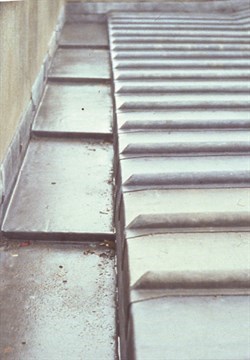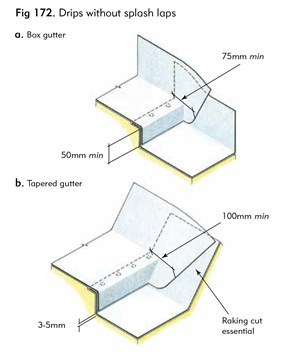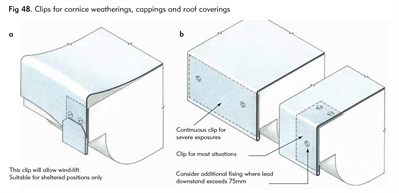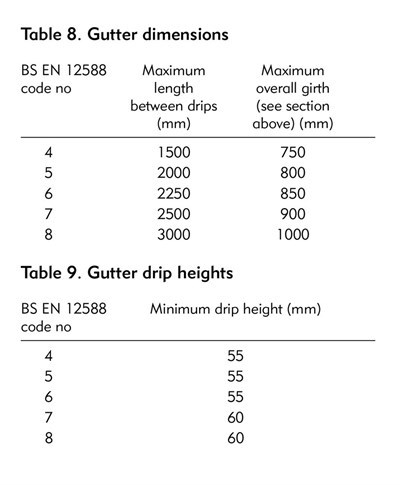The use of rubber expansion joints in lead guttering
[edit] Lead guttering: A flexible approach
A question that is often asked of professionals is about the correct way to fit a lead gutter. Should they be fitted in the traditional way with drips (steps) breaking up the lengths or can rubber expansion joints be used?
[Example of a typical box gutter]
One answer is that if it can be done the traditional way then it should be. However, if the situation means this can’t be done, there may be no choice other than to use an alternative method.
So what is a rubber expansion joint and when should it be used?
To a certain extent, the answer lies in its history. Neoprene expansion joints, to give them their proper name, were first used in Europe in conjunction with zinc and copper gutter linings. The idea being that a method of jointing was needed to take into account the thermal expansion of certain types of metals. Traditional methods for jointing copper gutters, again with steps along its length, could not be easily replicated in zinc as the material is not as malleable.
In the early-1990s, the same principle was introduced to leadwork. The reason for this was that traditional wall head gutters that were made from concrete and lined with lead, which can be found on many older buildings, needed the leadwork replaced.
Traditionally, the lead lining pieces were just lapped and water ingress was inevitable. As it was impossible to create the traditional steps in these installations, neoprene expansion joints were seen as a good solution.
Over the years, these types of joints have been applied in many different gutter situations and appear to be giving a good service life to date. Their popularity has grown given that they can be welded into place much faster than using traditional ‘bossing’ methods to form the drips.
[edit] Why is that a problem?
One of the main reasons that we refer to these as a ‘last resort’ is that they only carry a manufacturers guarantee of 5 - 10 years. Lead on the other hand is expected to give a service life in excess of 60 - 100 years.
Having a component within this that may have a shorter lifespan is an obvious weak point and one that should be avoided if possible. Their use should be restricted to places where there is no choice, as it may restrict any insurance backed guarantees and could, in certain circumstances, lead to costly replacement works which would require full scaffold access.
All leadworks should take into account the anticipated life of the building concerned. Where a shorter service life may be acceptable to a building owner or developer the use of neoprene expansion joints could be considered. By contrast, where maximum service life is required standard traditional details should always be used. If neoprene joints are proposed, this should be discussed with the client and built into any maintenance programme.
All the details used here are from the LSA's Complete Manual, which includes a wealth of detail on installation and specification. Further information and technical support is available at www.leadsheet.co.uk.
This article was written by Darren Tutt, Senior Technical Officer, The Lead Sheet Association
NB: Any detailing provided by the Lead Sheet Association refers to the use of Rolled Lead Sheet to BS EN 12588.
[edit] Related articles on Designing Buildings Wiki
Featured articles and news
Infrastructure that connect the physical and digital domains.
Harnessing robotics and AI in challenging environments
The key to nuclear decommissioning and fusion engineering.
BSRIA announces Lisa Ashworth as new CEO
Tasked with furthering BSRIA’s impressive growth ambitions.
Public buildings get half a million energy efficiency boost
£557 million to switch to cleaner heating and save on energy.
CIOB launches pre-election manifesto
Outlining potential future policies for the next government.
Grenfell Tower Inquiry announcement
Phase 2 hearings come to a close and the final report due in September.
Progress from Parts L, F and O: A whitepaper, one year on.
A replicated study to understand the opinion of practitioners.
ECA announces new president 2024
Electrical engineer and business leader Stuart Smith.
A distinct type of countryside that should be celebrated.
Should Part O be extended to existing buildings?
EAC brands heatwave adaptation a missed opportunity.
Definition of Statutory in workplace and facilities management
Established by IWFM, BESA, CIBSE and BSRIA.
Tackling the transition from traditional heating systems
59% lack the necessary information and confidence to switch.
The general election and the construction industry
As PM, Rishi Sunak announces July 4 date for an election.
Eco apprenticeships continue help grow green workforce
A year after being recognised at the King's coronation.
Permitted development rights for agricultural buildings
The changes coming into effect as of May 21, 2024.


























